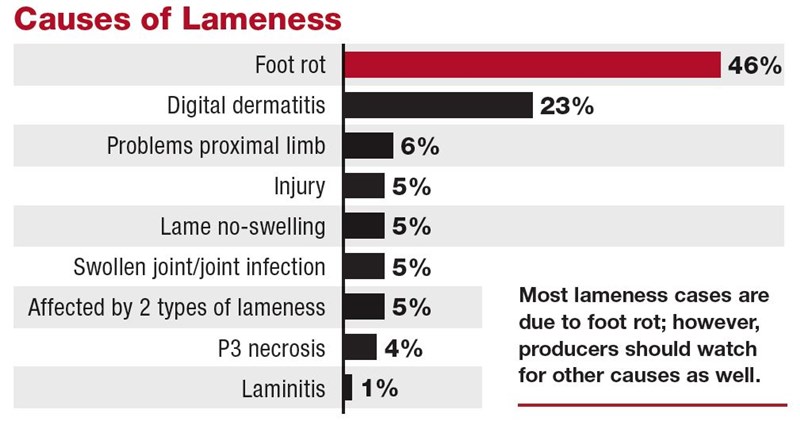Shine A Light on Lameness
It only takes a few video clips of a limping cow or feeder calf for an animal rights group to have a field day with the press.
The beef industry has already seen what these types of videos can do. The Humane Society of the U.S.’s undercover investigation of Hallmark/ Westland Meat Packing Company in 2008 led to the largest meat recall in U.S. history and forced beef producers to take a hard look in the mirror when it came to handling cattle.
Later in 2008, after the Hallmark/ Westland videos, animal scientists, veterinarians and cattlemen gathered for the first International Symposium on Beef Cattle Welfare to get a better handle on animal welfare. This past June, beef industry professionals met again for the fifth symposium to focus on lameness management.
Animal welfare and lameness share an obvious connection to each other, says Karen Schwartzkopf-Genswein, a senior scientist with Agriculture and Agri-Food Canada.
Lameness, and the pain that comes with it, modifies cattle behavior by animals laying down more and going o feed. It can equate to a longer stay in a sick pen and increased labor to handle a lame animal. In some cases, a lame animal can be unfit to go through traditional marketing channels such as an auction barn or packing plant.
In a recent research study analyzing lameness in feedlot cattle at two 10,000-head Alberta feedlots, Schwartzkopf-Genswein observed lame cattle weekly for two years by taking gait scores and physiological measurements. An additional health record study was performed at 29 feedlots from 2009 to 2014 with a total of 111,015 cattle records.
When the research was concluded, the incidence of lameness was 5.89% per year, compared to 9.44% occurrence for respiratory disease.
“We always talk about respiratory disease and what a problem it is, but lameness is second to it in incidence,” Schwartzkopf-Genswein adds.
The most common cause of lameness was foot rot at 45.7% followed by digital dermatitis 23.2%. Seven other causes of lameness were measured at less than 6% each.
Incidence of digital dermatitis, also known as hairy heel warts and strawberry foot, has started to increase in the feedlots Schwartzkopf-Genswein researches. While it is often seen in dairies, many feedlot cowboys in the past could have been misdiagnosing digital dermatitis as foot rot.
To make the proper diagnosis and treatment, Schwartzkopf-Genswein recommends picking the foot up in a chute and using a rope to elevate the hoof. Digital dermatitis does not have the swelling seen in foot rot.
Of the cattle treated throughout the study, 30.38% were doctored for some type of lameness and 8.07% relapsed, while 7.76% of euthanized cattle were from severe lameness.
“This tells me lameness is an important health and welfare issue in our feedyards,” she says.
The cost of management is high. Treatment costs ranged from $8.40 and $42.20. To retreat an animal, the cost increased $3.50 per head. Lame cattle took 15 days longer to finish on feed and weighed 108 lb. less than their healthy counterparts. Overall, an estimated $81.40 in production was lost per animal.
“Lameness is a greater economic cost than we ever thought it was. We really need to work on strategies for mitigation and management,” Schwartzkopf-Genswein says.
Looking forward at genetic trends Temple Grandin, animal handling expert with Colorado State University, believes selection for leg conformation could be falling to the wayside and it might increase the prevalence of lameness.
“One advantage to being around a long time is I remember this issue when it started in the 1980s in the pig industry,” Grandin says.
At that time she observed pigs with collapsed ankles, crooking legs and post legs. “You might have had 50% of market hogs that were lame.”
Today, Grandin is starting to witness similar leg conformation issues in the beef industry.
While it hasn’t reached a full crisis like the hog industry did, Grandin thinks cattle producers should be proactive. “We’ve got to head this one off at the pass. Let’s make sure it does not become a problem,” Grandin adds. “It is not a problem yet, but there are hints of trouble.”
A study from a graduate student Grandin advises looked at leg conformation and mobility of cattle arriving from 13 different states at five feedlots in Colorado and Texas. Looking at 2,886 cattle exiting the squeeze chute for the first time showed 86% of calves had good conformation in hoof and leg structure. An interesting finding was cattle originating from northern states had more genetic hoof abnormalities such as scissor claw on the front hooves compared to cattle coming from southern states.
Genomic enhanced EPDs have helped advance genetic progress, but producers still need to see cattle prior to making breeding decisions.
A second graduate student of Grandin’s is researching the four major semen sales companies’ websites to analyze photos of cattle featured. Only 19% of the bulls had fully visible feet and legs.
Similar to utilizing body condition scoring, Grandin encourages producers to look at leg conformation charts to evaluate how their cattle are doing and continue to do soundness exams.
“There are some people breeding cattle that don’t think we need visible appraisal. We need it to stay out of trouble,” Grandin says.








